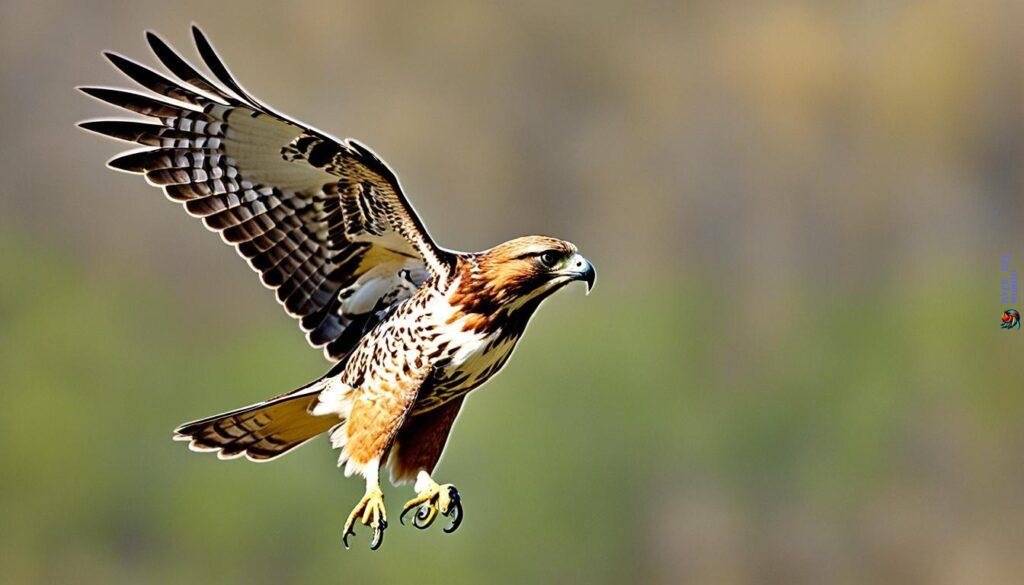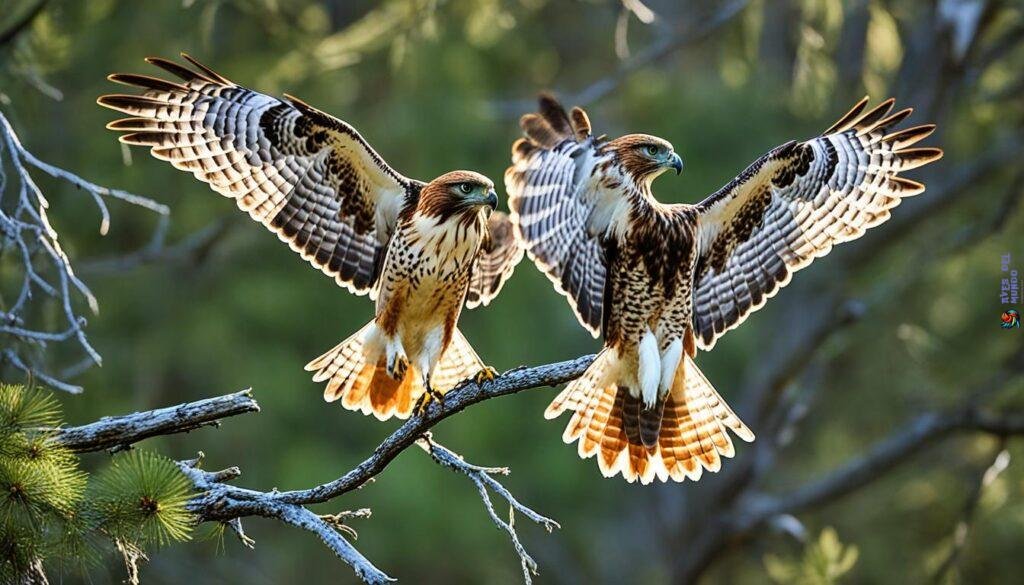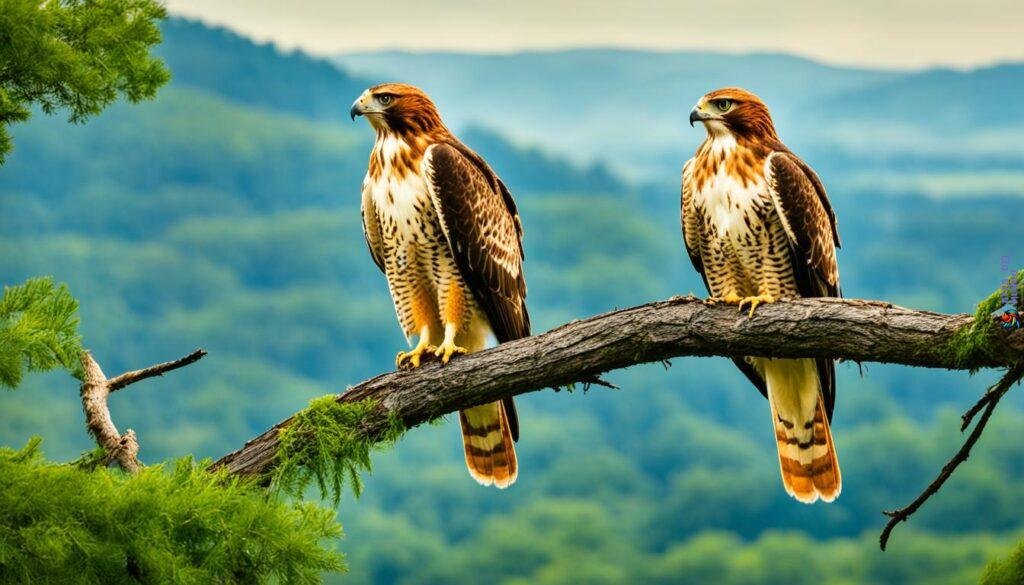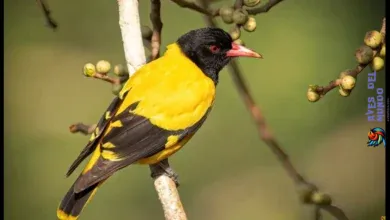Have you ever wondered how hawks exhibit their hunting prowess and perform their impressive aerial behaviors? As apex predators in the avian kingdom, hawks possess a captivating beauty and complexity that we can only truly appreciate by understanding their behavior. From their soaring techniques to their nest-building habits, hawks offer valuable insights into the fascinating world of birds of prey.
Key Takeaways:
- Hawks are majestic birds of prey known for their hunting prowess and aerial behaviors.
- Understanding hawk behavior provides insights into their hunting techniques, nesting habits, and territorial instincts.
- Hawks are apex predators with impressive physical characteristics, including a large wingspan and sharp talons.
- Hawks utilize hunting techniques such as soaring, ambushing, and pursuit to catch their prey with precision and efficiency.
- Observing hawks in their natural habitat allows us to appreciate their beauty and complexity as apex predators in the avian kingdom.
The Diet of Red-Tailed Hawks
Red-tailed hawks are carnivorous birds of prey, with a diverse diet that primarily consists of small mammals such as rodents and rabbits. Additionally, they are known to consume reptiles, birds, and insects. These majestic hawks employ various hunting techniques to secure their prey with precision and efficiency.
Hunting Techniques
Red-tailed hawks exhibit remarkable hunting techniques that allow them to capture their prey effectively. By utilizing their keen eyesight, they perch in elevated positions, scanning their surroundings for potential targets. Once a suitable prey is spotted, they swoop down swiftly, employing their powerful talons to firmly grasp their target.
These hawks employ an array of hunting methods, including soaring and ambushing, depending on the circumstances. Soaring allows them to scout large areas from the skies, making it easier to locate potential prey. On the other hand, ambushing involves surprising their quarry by launching a sudden attack from concealed locations, such as treetops or dense foliage.
This diagram illustrates the hunting techniques used by red-tailed hawks:

| Hunting Techniques | Description |
|---|---|
| Soaring | This hunting technique enables red-tailed hawks to cover vast distances while scanning the ground for potential prey. |
| Ambushing | Red-tailed hawks employ this method to surprise their prey by launching sudden attacks from concealed locations. |
These hunting techniques, coupled with their exceptional aerial agility, provide red-tailed hawks the advantage they need to secure their meals effectively. Their predatory prowess and diverse diet contribute to their survival as apex predators in their ecosystems.
The Habitat of Red-Tailed Hawks
Red-tailed hawks can be found throughout North and Central America, inhabiting a variety of habitats. These adaptable birds thrive in different environments as long as they have access to open areas for hunting and nesting sites that are safe from predators.
Red-tailed hawks are typically found in open areas such as fields or prairies. These expansive landscapes provide the hawks with clear visibility and ample room to soar and hunt for their prey. Open areas also offer suitable conditions for nesting and raising their young.

In addition to open areas, red-tailed hawks can also inhabit wooded areas. Forested regions offer shelter, perching spots, and potential prey sources for these majestic birds. They may choose to build their nests in tall trees, blending seamlessly with the surrounding foliage.
Moreover, red-tailed hawks demonstrate their adaptability by nesting on cliffs and even man-made structures such as buildings and bridges. These elevated locations provide the hawks with a strategic advantage, offering safety from ground-based predators and panoramic views of their hunting grounds.
Overall, the habitat of red-tailed hawks encompasses a diverse range of environments, including open areas, trees, cliffs, and man-made structures. Their ability to thrive in various habitats makes them a truly remarkable species of birds.
Mating Behavior of Red-Tailed Hawks
Red-tailed hawks, known for their majestic presence and hunting prowess, exhibit fascinating mating behavior. These birds are monogamous, meaning they mate for life, forming strong and lasting bonds with their partners. The mating season for red-tailed hawks typically occurs between February and May, during which they engage in courtship rituals to secure a mate.
The courtship begins with an impressive aerial display performed by the male. In this display, known as a stoop, the male red-tailed hawk dives down from a great height and pulls up just before reaching the ground, showcasing his agility and strength. If the female is impressed by this display, she joins him in the air, engaging in intricate flight patterns together.
Once paired, the male and female red-tailed hawks work together to build their nest, which is usually located in a tall tree. This nesting behavior reflects their strong bond and shared commitment to creating a safe and suitable environment for their offspring. The nest is often a large structure made of sticks and lined with softer materials such as leaves, moss, or grass.
The female red-tailed hawk lays a clutch of 2-5 eggs, which are incubated by both parents for approximately 28 days. This shared parental responsibility highlights the cooperative nature of red-tailed hawk mating pairs. After the eggs hatch, the young hawks, called fledglings, remain in the nest and rely on their parents for several months, gradually learning to fly and hunt.
Overall, the mating behavior of red-tailed hawks is a remarkable display of commitment and partnership. Their monogamy, courtship rituals, and nesting habits contribute to their success as a species and ensure the continuation of their lineage.

Key Points:
- Red-tailed hawks are monogamous birds that mate for life.
- Their courtship rituals involve impressive aerial displays, showcasing the male’s diving skills.
- Once paired, the male and female build a nest together, usually in a tall tree.
- The female lays 2-5 eggs, incubated by both parents for about 28 days.
- The young hawks, called fledglings, stay with their parents for several months before leaving the nest.
Nesting Habits of Red-Tailed Hawks
Red-tailed hawks are magnificent birds that exhibit fascinating nesting habits. As monogamous birds, they mate for life, forming strong and enduring partnerships. Their nesting season typically spans from February to August, during which they demonstrate their commitment to their chosen nest site.
These majestic birds prefer to nest in trees, although they can also utilize cliffs or man-made structures like buildings or bridges. By reusing the same nest site year after year, red-tailed hawks establish a sense of stability and familiarity, ensuring the long-term success of their nesting endeavors.
During the nesting season, the female red-tailed hawk lays a clutch of 2-5 eggs. Both parents take active roles in incubating the eggs, ensuring their warmth and protection. Incubation lasts approximately 28 days, during which time the parents diligently care for their developing brood.

Once the eggs hatch, the young hawks, known as fledglings, enter the world under the watchful eyes of their dedicated parents. They remain in the nest for several months, gradually growing in size and strength. The parents teach them vital skills such as flying and hunting, preparing them for their independent adult lives.
It is crucial to note that the nesting habits of red-tailed hawks play a significant role in their reproductive success. By selecting secure and strategically placed nest sites, these birds provide optimal conditions for the survival and growth of their offspring. Additionally, their monogamous nature ensures a stable family unit, facilitating effective parental care and nurturing.
Social Behavior of Red-Tailed Hawks
Red-tailed hawks are fascinating creatures known for their solitary nature, but during the breeding season, their behavior takes a remarkable turn. While they are typically solitary birds, they come together during the breeding season to establish territories and find mates.
Unlike many other bird species, red-tailed hawks are not social birds and prefer a solitary lifestyle for the majority of the year. However, during the breeding season, their social behavior becomes more apparent as they actively seek out potential mates and defend their territories.
Red-tailed hawks are one of the most common and widespread hawks in North America, inhabiting various habitats ranging from open areas to forests. During the breeding season, they utilize their social behavior to ensure successful reproduction and population growth.
The size of their territories is influenced by the availability of food resources and the need to attract potential mates. Red-tailed hawks rely on large territories where they can find enough food to support themselves and their young. A larger territory enhances their chances of attracting a mate and provides ample hunting grounds.
Understanding the social behavior of red-tailed hawks during the breeding season is crucial for gaining insights into their breeding success and population dynamics in different habitats. This understanding helps conservationists and researchers develop strategies to protect their habitats and ensure their long-term survival.

| Social Behavior of Red-Tailed Hawks during the Breeding Season | Description |
|---|---|
| Mating | Red-tailed hawks actively seek out potential mates during the breeding season. They engage in courtship rituals, such as aerial displays, to attract a suitable partner. |
| Territory Establishment | During the breeding season, red-tailed hawks establish and defend their territories. The size of their territories depends on the availability of food resources and the need to attract potential mates. |
| Pair Bonding | Once paired, red-tailed hawks form strong bonds with their mates and work together to build and maintain their nests. |
| Nesting | Red-tailed hawks choose suitable nesting sites within their territories. They build large nests using sticks and other materials. |
| Parental Care | Both male and female red-tailed hawks play active roles in incubating the eggs and raising the young fledglings. They provide food and protection until the young hawks are ready to leave the nest. |
Territorial Behavior of Red-Tailed Hawks
Red-tailed hawks are known for their highly territorial nature, fiercely defending their nesting and hunting grounds. These majestic birds require large territories to ensure they have access to enough food to support themselves and their young.
Their territorial behavior has been extensively studied, providing valuable insights into their ecology and natural history. Researchers believe that hawks utilize their territories not only for hunting but also to attract potential mates, showcasing their fitness and ability to provide for a family.
Defending Territories
Red-tailed hawks show remarkable dedication and aggression when it comes to protecting their territories. They engage in aerial displays, vocalizations, and physical confrontations to drive away intruders. These territorial behaviors are not only essential for securing resources but also for ensuring the survival of their offspring.
Observing red-tailed hawks in the wild as they defend their territories provides a firsthand experience of their impressive territorial behaviors. It is a testament to their strength, persistence, and unwavering commitment to protecting their hunting grounds.
Hunting Grounds
Their hunting grounds are a vital part of the red-tailed hawk’s territory. These birds rely on their territories to find ample prey to sustain themselves and their young. By defending their hunting grounds, they ensure a consistent food source to support their reproductive success.
Red-tailed hawks exhibit exceptional hunting prowess, employing various techniques such as soaring, ambushing, and pursuit. Their keen eyesight and powerful talons enable them to capture a wide range of prey, including small mammals, birds, reptiles, and insects.
Understanding the territorial behavior of red-tailed hawks provides valuable insights into their ecological role as top predators and their intricate interactions within their natural habitats.

| Territorial Behavior | Importance |
|---|---|
| Defending nesting and hunting grounds | Ensuring access to sufficient food resources for survival and reproduction |
| Displaying aggression and dedication | Deterrent to intruders and securing territory boundaries |
| Showcasing fitness and attracting mates | Ensuring successful reproduction and passing on genes |
Differences Between Red-Tailed Hawks and Red-Shouldered Hawks
Red-tailed hawks and red-shouldered hawks are two species of hawks that exhibit distinct differences in various aspects, including size, tail color, and habitat preferences.
Firstly, when it comes to size, red-tailed hawks are larger compared to red-shouldered hawks. Red-tailed hawks boast an impressive wingspan of up to 4 feet, while red-shouldered hawks have a slightly smaller wingspan in comparison.
Another noticeable difference lies in the coloration of their tails. Red-tailed hawks have a prominent red tail, which serves as a distinguishing feature. On the other hand, red-shouldered hawks possess a tail that is brownish-red in color.
Habitat preference is yet another contrasting factor between these two hawk species. Red-tailed hawks favor open areas such as fields and prairies, where they can easily spot and swoop down on their prey. Conversely, red-shouldered hawks tend to inhabit wooded areas that provide ample cover for their hunting activities.
Despite these differences, both red-tailed hawks and red-shouldered hawks are highly skilled hunters capable of reaching impressive speeds during their hunting pursuits. Their adaptations and behaviors contribute to their success as avian predators.
The Significance of Red-Tailed Hawks in Culture and Symbolism
Red-tailed hawks have long held a symbolic and cultural significance throughout history. Revered for their power, freedom, and wisdom, these magnificent birds have left their mark on art, literature, and mythology.
In many cultures and religions, red-tailed hawks are seen as symbols of strength and authority. Their striking appearance and awe-inspiring flight are often associated with power and leadership. They embody the spirit of freedom, soaring through the skies with grace and agility.
Native American folklore holds a deep respect for red-tailed hawks, considering them sacred and representative of spiritual connections. They are believed to bring messages from the spirit world and guide individuals on their life path. The wisdom and insight associated with these birds of prey make them powerful symbols of guidance and intuition.
Red-tailed hawks also symbolize the interconnectedness of humans with the natural world. Their ability to navigate vast landscapes and adapt to different habitats reflects our own need for harmony and balance in our lives. Through understanding the cultural significance of red-tailed hawks, we gain a greater appreciation for their beauty and the timeless wisdom they embody.



